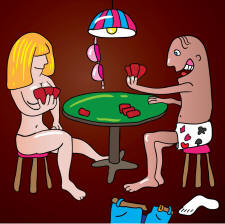Beating a Maniac at Heads Up Poker
Heads-up hands can be very difficult depending on your position, chip stack, and blinds. Each of these different factors will drive a heads-up match in a different direction. However, more importantly, your most important factor in a heads-up match is the opponent you're playing and what strategy he or she is using against you.
One of the most difficult types of opponents to play against is an extremely aggressive player that never lets up throughout the match. With the payout structure making first and second place finishes differ greatly in prize money, it is important to play well in a heads-up match to take home first place.
Maniac players will continue to overplay their hands no matter the value or position either have. In heads-up matches your hand values with automatically rise, and while playing against a very aggressive player, the hand values will increase even more. It is important to be patient against an extremely loose player, but when you make your moves, make them aggressively.
Heads Up Position
 Because there are only two positions in heads-up play, this will be a
major advantage for you against an aggressive player. The dealer will be
required to make his or her first act; fold, raise, or call the blind.
If you sit in the dealer position you will have position the entire
hand. Now, against a very passive player, raising nearly every hand in
the dealer position is very common in order to steal the blinds.
Because there are only two positions in heads-up play, this will be a
major advantage for you against an aggressive player. The dealer will be
required to make his or her first act; fold, raise, or call the blind.
If you sit in the dealer position you will have position the entire
hand. Now, against a very passive player, raising nearly every hand in
the dealer position is very common in order to steal the blinds.
However, a very aggressive player is likely to call this raise pre-flop so consider only raising with stronger hands such as A8, K10, or any pair. These hands are very likely to be the best hand, and if you were to simply limp-in pre-flop, the aggressor may raise and pressure you the entire hand if you were to only flop a very marginal hand. So avoid limping in pre-flop and stick to folding or raising a strong amount (around 4x the big blind).
In big blind position, you are likely to be raised nearly every hand when the aggressive player is first to act pre-flop. If you are holding a semi-strong hand such as the A8, K10 or pair, consider another strong re-raise pre-flop in order to make him or her fold. Many of these aggressive players will attempt to raise pre-flop but surrender their hands when played back at pre-flop.
If you were to simply call a raise pre-flop and flop a major hand, let the aggressor continue to pressure you, acting as if you are holding a marginal hand. Extremely aggressive players will nearly always pay you off when you complete a straight, flush or flop a set.
Chip Stacks
Chip stacks are also very important during a heads-up match, and having the short stack or large stack will greatly differ how you play against a maniac.
If you are fortunate enough to have the larger stack, you may have the opportunity to wait for a major hand and once again let the aggressor pay you off. You now have the opportunity to see the flop after a pre-flop raise with great drawing hands such as 67hh, or J10cc. Most of the time you can see a cheap flop with these hands and possibly flop a major hand to have the aggressive player pay you off.
However, if you sit with a small stack against a very aggressive player, the play will be much more aggressive because his or her chip stack will only add to the aggressiveness. In this case, the odds are that the blinds will be pressuring you along with your opponent. This is where you must consider how valuable your hand may be against an aggressive player with a large chip stack. This player will likely raise you nearly every hand, and you can play back (re-raise all-in) with hands as weak as K9, Ax, or definitely any pair.
Overall Strategy
All in all, against a very aggressive player, marginal hands will become re-raising hands pre-flop. Also, if you happen to flop a major hand or draw, this may be your opportunity to get all of your money in when he pressures you on the flop, or to slow play the major hand. Many of these players will surrender hands to re-raises pre-flop because they enjoy taking blinds and antes as well.
Postflop play is just as important as preflop -raises, position, and chip count as well. If you have simply flopped mid-pair, you may wish to call the aggressor down to the river even if you do not improve. Although it is best to avoid the check-call move in first position after the flop, sometimes this play works very well. If the aggressive player over bets the pot on the flop, playing back at him with a check-raise may be your best shot, and if he shows weakness by checking, bet. The few times that aggressive players show weakness, they are very likely to give the pot up.
